- For the game, see The Elder Scrolls V: Skyrim.
- "Skyrim, also known as the Old Kingdom or the Fatherland, was the first region of Tamriel settled by humans from the continent of Atmora: the hardy, brave, warlike Nords, whose descendants still occupy this rugged land."
- ―Imperial Geographic Society[src]
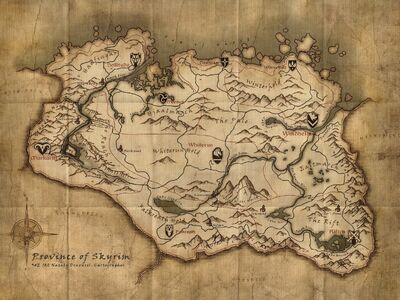
A map of Skyrim
Skyrim, also known as the Old Kingdom, Throat of the World,[1] the Fatherland or Keizaal (Dovahzul: Keiz-Aal, "Rebellion-May"[note 1]), is a vast region set in the northern part of Tamriel.[2] It is home to the Nords, large and hardy men and women who have a strong resistance to frost, both natural and magical.[2][3] Skyrim was originally inhabited by a race of Mer known as the Snow Elves, though after the Atmoran-Snow Elf War, the Snow Elves were all but destroyed and the Atmorans settled the land.[4] It is bordered by Morrowind to the east, the Nibenay and Colovia in Cyrodiil to the south, Hammerfell to the southwest, and High Rock to the west. The island of Solstheim lies to the northeast of Skyrim, now sovereign territory of Morrowind.
By game
History
Merethic Era
- Main article: Merethic Era
Skyrim, also known as the Old Kingdom or the Fatherland [2][5] is the home of the Nords.
Expedition to Skyrim
During the Merethic Era, a legendary Atmoran leader named Ysgramor led an expedition from Atmora to the land that would later be known as Skyrim.[6][7] They called the land Mereth, in recognition of the vast number of Mer that lived there. It was the first region of Tamriel to be settled by humans, who migrated there from the land of Atmora in the far north, across the Sea of Ghosts.[8] According to legend, Ysgramor landed first at Hsaarik Head, at the extreme northern tip of Skyrim's Broken Cape.[7] It is said that he and his companions were fleeing the civil war in Atmora, which at that time had a sizable population.[5]
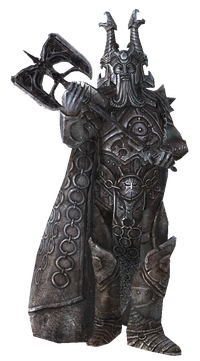
Ysgramor formed the Five Hundred Companions.
The Atmorans settled the area that in the future would be known as Winterhold; they eventually built a city in the region and called it Saarthal.[7] For a long while, relations between the Snow Elves and the Atmorans were relatively peaceful.[5]
Night of Tears
- Main article: Night of Tears
The Night of Tears was the infamous sacking of Saarthal by the Snow Elves. There are a variety of accounts as to why this happened. Some say the Snow Elves saw that the Nords, with their considerably shorter life expectancy, fast rates of physical maturation and expedient (by Elvish standards) reproductive cycle, would eventually overtake them if left unchecked.[5] Another theory suggests that the sacking of Saarthal was brought on by the Atmoran discovery of the Eye of Magnus beneath the city.[9] Other sources are less certain in their pronouncements, but also point to a very focused attack on locations that are not of strategic importance, lending weight to the theory that the Eye of Magnus, not the extermination of the Nords was the primary reason for the attack.[10] According to legend, only Ysgramor and his two sons were able to escape back to Atmora.[5][11]
The Return
- Main article: The Return
When Ysgramor and his sons returned to Atmora, they told stories of the events that occurred in Skyrim, and gathered many around them for a return to retake Skyrim and avenge Saarthal.[11] After Ysgramor was set to return to Skyrim with an army known as the "Five Hundred Companions," composed of the heroes of the Atmoran Civil War.[5] On the Day of Final Passage, the Five Hundred Companions left the port of Jylkurfyk to return to Skyrim.[11]
Atmoran-Snow Elf War
The Atmoran-Snow Elf War took place in the late middle Merethic Era,[7] and was a campaign which seemed to be indecisive for much of its duration.[12] The battle that decided it for the Atmorans was the Battle of the Moesring. During the battle, the Atmorans were winning and it appeared that they would be victorious, until the arrival of the Snow Prince.[13] He rallied and led his forces into combat, inspiring the troops of the last remaining army of Snow Elves, before allegedly being killed by a small child. The death of the Snow Prince shattered the morale and motivation of the remaining Snow Elf warriors. Many Snow Elves fled, and those who remained on the battlefield were killed.[13] The Snow Prince himself was buried with honors by his Nord foes.[13][14]
The war would end shortly after, and was followed by a purge of Skyrim's remaining Snow Elves. The Five Hundred Companions, without much resistance, secured the region and laid the foundations for the Ysgramor Dynasty.[14][13]
War against the Giant clans of Sinmur
Ysgramor and his Five Hundred Companions not only fought the Falmer, but also the Giants. After many hundreds slain in battle, the Giant of Legend, Sinmur, was cornered in his own barrow and fought Ysgramor to the death. However, the Giant was no match for Ysgramor's mighty axe, Wuuthrad. The axe was driven into Sinmur's skull after he was brought to his knees by Ysgramor. With the death of Sinmur, the Giants were never as mighty a threat and so the war ended.[15]
Founding of Whiterun
After the war against the Snow Elves, the Five Hundred Companions broke into separate groups to find their own way in the newly conquered land. The crew of Jorrvaskr, led by Jeek of the River, journeyed around Skyrim until they came upon a mysterious yet wondrous sight; "a monument of a bird, whose eyes and beak were opened in flame." This monument, that would soon later known be known as the Skyforge, was older than the Snow Elves themselves.It was supposedly as old as Nirn and was "some remnant of the god's efforts to render a paradise in Mundus before the shattering of Lorkhan." A city was built up around Jorrvaskr, and this city became known as Whiterun, with the initial area around it later known as Whiterun Hold.[16]
Founding of Windhelm
Ysgramor and his group traveled eastwards, heading towards Yngol Barrow. After stopping there, Ysgramor's eyes turned to the south, where a river met the sea. He decreed that he and his crew would build a great city, in monument to the glories of Mankind, and so he could look upon his son's final resting place and "feel that his line would know peace in this new home that was never known in Atmora." The city was built with a long bridge stretching across the White River, with much of the city made of stone. This city would be known as Windhelm, the City of Kings.[17]
Dragon War
- Main article: Dragon War
Disclaimer: There is not much information on the dragons' government and its timeline. The lore would suggest that the rule of the dragons preceded the greater wave of Atmoran colonization,[18] and there is also little information about the dragons' interaction with the Dwemer and Snow Elves and their activities outside of Skyrim.
- "When the populace rebelled, the dragon priests retaliated. When the dragon priests could not collect the tribute or control the masses, the dragons' response was swift and brutal. So it was the Dragon War began."
- ―The Dragon War, by Torhal Bjorik on the beginning of the Dragon War[src]
When the Atmorans came to Skyrim, they brought with them their history and culture, including their religion. Their religion focused on the worship of animal gods, the chief deity of which was the Dragon. Just as Dragons ruled supreme in Atmora, with dragon priests being their lieutenants to whom actual governance was left, the same occurred in Tamriel.[18]
At an unknown time, the people of Skyrim rebelled against the Dragons. At first, people died by the thousands.[18] Later, Kyne, the Nordic goddess of the Storm, intervened to help Mankind. She gave Paarthurnax the task of teaching Mankind the Voice.[19]
The tide began to turn in favor of Man, and eventually Dragons were hunted down and the cultists were killed or overthrown. The Atmorans solidified their victory after Hakon One-Eye, Felldir the Old and Gormlaith Golden-Hilt seemingly vanquished the Dragon lord Alduin.[20] Mankind would win the Dragon War, with many Dragons killed and the remnants of the Dragon Cult dispersing and going into hiding. What was left of the Dragon Cult built the Dragon mounds, entombing themselves and the remains of the dragons that died during the war with the belief that Alduin would one day return and resurrect the faithful.[21][18]
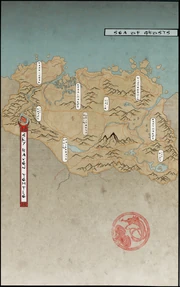
Akaviri map of Skyrim in the First Era.
First Era
- Main article: First Era
Split with Atmora
Snow Elves persisted within the borders of Skyrim until the reign of the Thirteenth of the Ysgramor Dynasty, King Harald, at the beginning of the First Era. King Harald was the first to relinquish all holdings in Atmora (until that time, the Nords of Atmora and Skyrim had been considered the same group), proclaiming that the people of Skyrim were an independent people.[5]
The First Empire of Men
Vrage the Gifted started the expansion that would eventually lead to the First Empire of Men. Within fifty years of his reign, the Nords ruled all of Skyrim as well as parts of High Rock, Cyrodiil, and the Dunmer lands of Morrowind.[5]The acquisition of Morrowind was particularly bloody, still remembered by the Dunmer. The purpose of the formation of the Chimer-Dwemer kingdom of Resdayn was to expel the Nords.[22][23]
War of Succession
In 1E 369, High King Borgas was killed during the Wild Hunt. His death led to the start of Skyrim's War of Succession.[5][24] The War of Succession caused Skyrim's influence over many of its dominions to wane. The Direnni Hegemony took advantage of the internal strife in Skyrim, and began taking land north and south of High Rock, even claiming portions of Skyrim at certain moments.[25]
First Battle of Red Mountain
In 1E 416, the discord produced by the War of Succession greatly weakened the Nords and caused them to be expelled from Morrowind during the First Battle of Red Mountain (the Second Battle of Red Mountain would occur in 1E 700). The Nords lost all of their territory in Morrowind, and their armies suffered huge casualties at the hands of the combined Chimer-Dwemer army.[22][5]
War of Succession ends
- "Subdued the foul dragon Numinex,
reunited Skyrim after the war of
Succession, and conquered the
barbarous Reach." - ―Windhelm Palace of the Kings Plaque
In 1E 420, the Skyrim War of Succession ended with the Pact of Chieftans and the crowning of Olaf One-Eye as High King.[5][26] Records indicated that Olaf expanded Skyrim's boundaries when he conquered the Reach.[27]
Following Olaf's reign, the Crown of Verity was created to ensure that the Moot would select a ruler worthy enough to rule Skyrim.[24] The crown caused controversy when it rejected the Moot's choice of King, Asurn Ice-Breaker. Following this rejection, Asurn was then killed by Kjoric the White, who took the crown for himself.[24]
War of Righteousness
Relations soured with Cyrodiil when Kjoric rebelled against Emperor Gorieus and his Alessian Army, but was killed at the Battle of Sungard in 1E 477 or 478.[28] His son and heir, Hoag Merkiller, resented the Alessian Order so much that he allied with the Direnni Hegemony and King Rislav Larich's insurgents in their war against the Order. Hoag was soon killed at the Battle of Glenumbra Moors and his successor, Wulfharth, continued his predecessor's work in devastating the Alessian Order.[28]
King Wulfharth
High King Wulfharth reestablished the Nordic pantheon as the mainstream faith in Skyrim, drove the Direnni Hegemony from Skyrim,[27] and waged war against the Orcs. Legend has it that Wulfharth drew the ire of the Orcs' god Orkey, and that he had the ghost of Alduin Time-Eater reduce all the Nords to the age of six.[29] Wulfharth pleaded with Shor to aid them and supposedly Shor's own ghost fought the Time-Eater on the spirit plane, as he did at the beginning of time, and won. Orkey's followers, the Orcs, were ruined by this act. Wulfharth watched the battle in the sky and learned a new thu'um that would change his people back to normal. But in his haste to save so many, he shook too many years out on himself. He grew older than the Greybeards themselves, and died.[29]
Allegedly, Wulfharth would later be resurrected as Shor's avatar and united the sons of Skyrim to invade Morrowind and reclaim the Heart of Lorkhan. The initial battles for the Nords were devastating after making landfall. Although they thought the Dwemer and Chimer armies would be weaker with reports of them warring with each other, they were surprised to be beset by both armies.[29] Believing that Shor's army would need all the strength it could muster, Wulfharth had also allied himself with orcish clans and House Dagoth in his holy war, much to the vexation of some Nords who still clung to old hatreds. Some tales claimed Voryn Dagoth deceived Wulfharth and the Nords into believing he was an ally, and betrayed the sons of Skyrim by leading them into a combined Dwemer-Chimer ambush. Other tales claimed that some of Wulfharth's Nords deserted him when he allied himself with their traditional enemies and fell in the climactic battle with the combined Dwemer-Chimer army. Ultimately, Wulfharth died at the Battle of Red Mountain in 1E 700, either by being weakened by Dumac and slained by Indoril Nerevar, or blasted away into ashes by Vivec.[29] The Tribunal wrested Kagrenac's Tools and the Heart of Lorkhan from Voryn Dagoth and used them to give themselves divine powers. Unbeknownst to them, Voryn Dagoth did not die from their conflict but had secretly connected himself to the Heart long ago, turning into Dagoth Ur and becoming a divine being himself.[30]
Second Era
- Main article: Second Era
Akaviri Potentate
While the Akaviri Potentate saw the decline and disintegration of much of the Second Empire, Skyrim was one of the most rebellious provinces in this respect, destroying a fortress at Dawnstar, which catalysed the Potentate to crush all other large-scale armed forces on Tamriel.[31]
During this period, Skyrim maintained most of its own structure, with the Moot continuing to elect kings and functioning largely independently of Versidue Shae and his son. King Logrolf was the last High King during the Potentate, and was assassinated in 2E 431.[24]
The Interregnum
Following Logrolf's assassination, the Crown chose his daughter, Freydis, as High Queen. This was disputed by Svartr, the Jarl of Solitude, who held a partial moot to proclaim himself High King in the west, signaling the split of Skyrim into two kingdoms.[24] Svartr was unable to keep an influx of orcs fleeing the recent destruction of Orsinium out of his realm, and the chieftain Yashnag Gro-Yazgu, along with increasingly rebellious Reachmen, was a disruptive presence in the West for several decades, although some sources claim this was confined to Falkreath. This was ultimately ended in 2E 467 when Hakkvild slew Yashnag in single combat. Without a leader, the orcs scattered into the Wrothgarian Mountains.[32]
The Second Akaviri Invasion of Tamriel
The Second Akaviri invasion landed east of Windhelm in 2E 572, rather than landing on the east of Morrowind.[33] The leader was the king of the Kamal, Ada'Soom Dir-Kamal.[33] They sacked Windhelm, and killed Queen Mabjaarn and Nurnhilde, her heir.[34] Jorunn, her younger son, either escaped the sack, or was in Riften and came to Windhelm as the gates fell.[34][35] In response to this invasion, the Ebonheart Pact is formed.[36]
Jorunn and rallied troops from across eastern Skyrim, including summoning the spirit of Wulfharth to help the Nords. Following the return of Jorunn, now calling himself King Jorunn, the Nords held the Akaviri at bay while the Dunmer approached from the East and cornered the Akaviri at Stonefalls, and, supplemented by a legion of Argonians, drive the Akaviri into the sea.[33]
Another account claims that Jorunn and Fildgor Strong-Prince arrived at the battle at the same time, and following the invasion dueled for the kingship of Eastern Skyrim to avoid civil war.[35] After three hours of fighting, Jorunn emerged victorious and banished Fildgor, who fled to the Daggerfall Covenant.[37] Ten years after the formation of the Pact, Jorunn is noted to be its head.[36]
Battle of Sancre Tor
- Main article: Battle of Sancre Tor
In 2E 852, an allied force of Nords and Bretons occupied the fortress of Sancre Tor in the Jerrail Mountains in northern Cyrodiil, which was then besieged by Talos under the authority of King Cuhlecain, and defeated through Breton treachery.[38] Following the battle, the Nords swore allegiance to Tiber Septim, and joined the efforts to conquer Cyrodiil. Note that available texts regarding the battle do not say that this was the point where Skyrim joined the Second Empire, merely that Nordic troops joined the Cyrodiilic army.
Reunification
There is no documented account of how or why Skyrim was reunified, but it had presumably been a single entity for some time when the first Pocket Guide to the Empire was published in 2E 864, as its division and reunification does not merit a mention in the text.[39] Another possibility is that the Imperial Geographic Society had some motive to hide the fact that the kingdom was ever divided. It is also likely that Tiber Septim reunified Skyrim through his actions at Sancre Tor in 2E 852.
Third Era
- Main article: Third Era
The Wolf Queen
Princes Potema, child of Pelagius II, known to Tamrielic history as the "Wolf Queen", was married to King Mantiarco, noted as "King of Solitude", in 3E 82, when she was 14, and had her first child, Uriel, after many miscarriages, in 3E 97.[40] In the intervening years, she spent much time gaining the allegiance of other Skyrim nobility.[41] She initially attempted to be made Empress herself by forging a letter by her brother, claiming he knew he was a bastard, but she was discovered.[42] Following this, Potema and her son Uriel attempted to have her brother's heir, Kintyra, declared a bastard before co-ordinating several attacks on the empire across Skyrim and High Rock,[43][44] and ultimately a succressful attack on the Imperial City in 3E 121. These initial attacks resulted in the Empress Kintyra's capture in 3E 121 and execution at Glenpoint Castle in High Rock,[45] and Uriel proclaiming himself Uriel Septim III.[44] This triggered the War of the Red Diamond.
The War of the Red Diamond lasted for six years, between the rival claimants. Uriel was captured after the Battle of Ichidag in Hammerfell in 3E 127, and killed by a mob while en route to Cyrodiil for trial.[46] Following this, Potema's allies deserted her and swore loyalty to Cephorus, while Potema summoned Daedra and raised undead to serve her dwindling armies in the next years. After a 3-year siege of her castle in Solitude, the Wolf Queen was declared dead in 3E 137.[47]
The Oblivion Crisis
At the beginning of the Fifth Century of the Third Era, the Oblivion Crisis began with Mehrunes Dagon's attempt to enter Tamriel in his "true and terrible form." Oblivion Gates opened up all over Tamriel, and a massive war between Mortals and Daedra ensued. Though most of the fighting took place in Cyrodiil, it is known that Oblivion Gates opened up all across Tamriel.[48]
Fourth Era
- Main article: Fourth Era
The Red Year and its Aftermath
- "Untithed to any thane or hold, and self-governed, with free worship, with no compensation to Skyrim or the Empire except as writ in the Armistice of old wheresoever those might still apply, and henceforth let no Man or Mer say that the Sons and Daughters of Kyne are without mercy or honor."
- ―Skyrim's offer of Solstheim to Morrowind in 4E 16[src]
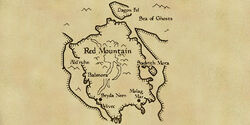
Map of Red Mountain.
In 4E 5, Red Mountain erupted in Morrowind. Much of the land was destroyed, and as such many Dunmer were forced to flee their homeland.[49] to 4E 6.[50] In 4E 16 the High King of Skyrim gave the island of Solstheim to the Dunmer, giving the refugees coming from Morrowind a place to live.[51][52] Four years later, in 4E 20, the Decree of Monument was signed by the Jarls to "decree this site as a monument to the struggle of those who fled their native home of Morrowind in the time following the Red Year."[53]
The Forsworn Uprising
In 4E 174, a group of Reachmen launched an uprising in which they took the city of Markarth. This event would later be known as "The Forsworn Uprising." Since the Empire was fighting against the Third Aldmeri Dominion in Cyrodiil at the time, Markarth was undefended and was thus left open for attack. The Reachmen who took control of Markarth took over the government administration and created an independent Reach kingdom.[54]
Markarth Incident
- Main article: Markarth Incident
Two years later, in 4E 176, Hrolfdir, who was the Jarl of Markarth prior to the Reachmen reclaiming it, asked a militia force led by Ulfric Stormcloak to retake Markarth.[55] The militia was victorious, however, many people who were related to the Forsworn were put to the sword and killed, those of the Forsworn who didn't flee Markarth were killed, except for Madanach, Nepos the Nose and a handful of others.[56][54][57] Those of the Forsworn who did manage to escape swore revenge against the Nords for preventing them a life of independence.[54][3] After this the Imperial Legion returned and had to accept the agreement of free Talos worship, which was made between Ulfric and Hrolfdir, supposedly due to chaos running through the streets in Markarth.[54] However, some time after this the Thalmor found out that the Empire wasn't honoring the White-Gold Concordat, and demanded them Ulfric and his men to be arrested or to face another war.[58] The choice was clear for the Jarl, Ulfric and his men were arrested and the Thalmor came to Skyrim with their treaty enforcers, the Thalmor Justiciars, to ensure that the Talos ban wouldn't be dishonored again.[59][60] It was the founding day for the Stormcloaks and where the civil war in Skyrim truly started.[58]
Skyrim Civil War
- "When the sons of Skyrim would spill their own blood."
- ―Esbern, describing the Skyrim Civil War[src]
- "The World-Eater wakes, and the Wheel turns upon the Last Dragonborn..."
- ―Prophecy of the Dragonborn[src]
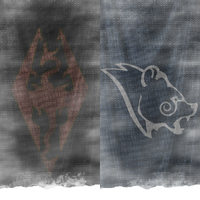
The banners of the Imperial Legion and the Stormcloaks.
- Main article: Skyrim Civil War
The Civil War in Skyrim is known to have started prior to 4E 199[61] and after 4E 176.[54] The exact cause for the war is a matter of debate in the province. On the Imperial side it is generally thought that Ulfric coveted the High King's throne and that he's just in it for the throne.[62][63] On the Stormcloak side however, people see him as a liberator who tries to free Skyrim from the claws of a corrupt and dying Empire.[64][65][66] Whiterun is neutral in this war and its Jarl claims that it will stay that way until the Hold is forced to draw its sword against one side or the other.[67] There haven't been recorded any significant clashes in the Civil War prior to the Dragonborn arriving in Skyrim. Save from a few skirmishes outside of Windhelm[66] and Whiterun[68] and Skyrim in general. As a result, not much territory has been gained by either side.
Dragon Crisis
The Dragon Crisis was a series of events that occurred in 4E 201, when Alduin, the Nordic god of destruction, returned to Tamriel. He, along with the many dragons that he resurrected, caused destruction and chaos throughout Skyrim, already in strife from the Skyrim Civil War. However, a mysterious individual—later revealed to be the hero of legend, the Dragonborn—rose up and was able to defeat Alduin, as foretold by the Elder Scrolls.[69]
The main questline of The Elder Scrolls V: Skyrim prominently features the Dragon Crisis.[70]
Geography
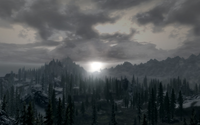
Skyrim features arctic tundra, mountains, and forests.
Skyrim is the most rugged region on Tamriel; not only containing five of the highest peaks on the continent, but also very snowy and cold. Much of Skyrim is vertical; mountains, cliffs, and deep valleys. The vast majority of settlements cling to these valleys.[5]
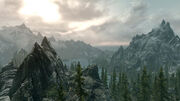
Flora and fauna
Flora
A vast number of types of flora are found throughout Skyrim. Plants can be found anywhere in Skyrim, even in the least hospitable of locations. Flora such as Snowberries and Frost Mirriam are capable of surviving in cold, harsh conditions. There are nine types of Fungi found in Skyrim. These can be found in cave networks beneath the surface. Of particular note are Jazbay grapes, originally a rare delicacy, tundra cotton, an alternative clothing fibre to animal skins, and Bleeding Crown, a fungus common to many of Skyrim's caverns.[71]
One of the most intriguing plants in Skyrim is the Nirnroot plant. Nirnroot typically grows near fungi and water resources, and depends on water and sunlight to survive. This rare plant is light green or crimson[72] and emits a very bright glow, as well as a chiming sound. Nirnroot flourished on Skyrim and all of Tamriel until the event known as the Sun's Death (1E 668), which catastrophically affected almost all plant life, including Nirnroot.[73]
Fauna
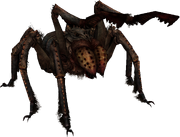
A frostbite spider, a common creature in Skyrim.
- Main article: Creatures (Skyrim)
A number of animals found in Skyrim are domesticated. These include the dogs, horses, chickens, cows and goats. The horses of Skyrim are hardy and strong, and "make up for endurance what they lack in speed."[74] Horses and horse-drawn carriages are commonly used as methods of transportation. Both are capable of traveling the harsh terrain and climate with ease.
Holds
- Main article: Hold
Holds are the nine administrative sections of Skyrim.[5][75] Scattered across the rugged landscape of Skyrim are five major cities and four minor ones, as well as minor towns, villages and settlements.
The Pale
- Main article: The Pale
The Pale is one of the four oldest holds in Skyrim, known collectively as Old Holds.[5] Its unique shape resembles that of a boot. Its coat of arms is a four pointed star. The Pale is located in the central northern area of Skyrim and extending to the northern coast where Dawnstar is situated. The hold borders Hjaalmarch to the west, Whiterun to the south, and Winterhold and Eastmarch to the east. Most of the region is treacherously cold with pine forests that stand facing the harsh winds whipping down the mountains.
Dawnstar
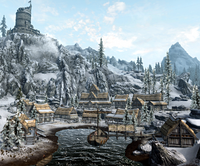
Dawnstar.
- Main article: Dawnstar
A garrison town on the northern coast of Skyrim, the port of Dawnstar is the trade center of the region.[75] Once the location of a major Imperial fortress until its destruction in 2E 283.[31] Dawnstar is one of the northern most cities in Skyrim along with Solitude and Winterhold.
Falkreath Hold
- Main article: Falkreath Hold
Falkreath Hold is the second southernmost hold in Skyrim, after The Rift. It borders Cyrodiil to the south and Hammerfell to the west, with a single road leading to both provinces. Other than its capital, Falkreath, the other notable town in the hold is Helgen, the first settlement in Skyrim to be attacked by a dragon during the Dragon Crisis and also the first visited by the Last Dragonborn after their arrival in Skyrim.
Falkreath
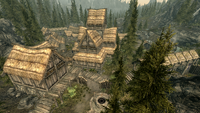
Falkreath.
- Main article: Falkreath
Falkreath is a city in southwestern Skyrim, capital of Falkreath Hold. It is close to the border with both Cyrodiil and Hammerfell. Falkreath is known for its cemetery, which dominates the southern part of the town.
The Reach
- Main article: The Reach
The Reach is infamous for harboring the Forsworn, Reachmen who are fighting a long war of independence and seek to retake Markarth from the Nords and free the hold from Imperial authority. With the constant threat of Forsworn attacks looming over Markarth and its surrounding settlements, the Reach is often considered the most dangerous hold of Skyrim, fit only for seasoned adventurers or hardened mercenaries.
Markarth
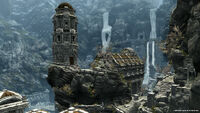
Markarth.
- Main article: Markarth
- "Nothing ever changes in the City of Stone, and that's just fine."
- ―The City of Stone[src]
A city in west-central Skyrim, Markarth is the capital city of The Reach. Markarth was notable for possessing the Imperial College of the Voice, which was founded by Tiber Septim to restore the Voice to the art of warfare.[5] Half of the town is controlled by a wealthy family known as the Silver-Bloods. Violence runs rampant throughout most of the city due to the Forsworn and government corruption.[3]
Hjaalmarch
- Main article: Hjaalmarch
Hjaalmarch is located in northern Skyrim, at the mouth of the Karth River. Morthal lies near the center of the hold. The hold borders Haafingar, separated by the Karth River to the northwest, The Reach to the west, Whiterun to the south and The Pale to the east. Much of the terrain is covered by wetlands, marshes, and swamps,
Morthal

Morthal
- Main article: Morthal
Morthal is a small city in North central Skyrim in the Drajkmyr Marsh.[76] A common legend about The Pale Lady has been spread around Morthal. It tells of a story about a dangerous ghost who stalks the marshes to find her daughter.[77]
The Rift
- Main article: The Rift
Riften
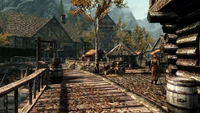
Riften.
- Main article: Riften
Riften, also known as Rifton,[78] is capital of The Rift. This town is located in south-eastern Skyrim, close to the province's borders with both Cyrodiil and Morrowind. Home to the Skyrim Thieves Guild, it was in Riften that Barenziah joined the Guild during her return to Morrowind from exile in Skyrim.[79]
Maven Black-Briar is one of Riften's most influential figures, and has de facto control of both the Riften Guard and the Jarl, as well as connections in both the Thieves Guild and the Dark Brotherhood.
Haafingar
Haafingar is the smallest Hold by area. Its symbol is a wolf's head. Since the Fourth Era, the High King of Skyrim reigns from Solitude. The hold is separated from Hjaalmarch by the Karth River and The Reach by mountains. Dragon Bridge is the only access to the hold by road, crossing the Karth River. Much of the hold is rocky and mountainous with soaring snowy mountains surrounding the north and west of Solitude, though the lower lying areas including Dragon Bridge are mostly comprised of forests and hills.
- Main article: Haafingar
Solitude
- Main article: Solitude
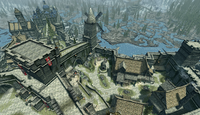
Solitude.
Solitude is the center of Imperial influence within Skyrim and capital city of Haafingar. Castle Dour is located there, from which General Tullius runs the Imperial Legion in Skyrim.[3] The nobility are housed within the Blue Palace. Solitude is located far to the northwest. Solitude is a major port, and its ships control much of Skyrim's northern coastline.[12]
Solitude houses Skyrim's Bards College, which enjoys a lively reputation for merrymaking. In particular, students invade the marketplace each year for a week of celebrations,[5] the climax of which is the burning of "King Olaf" in effigy, possibly a now-forgotten contender in the War of Succession.[80] Graduates have no trouble finding employment in noble households across Tamriel, and many take to becoming wandering minstrels, providing entertainment in courts across Tamriel.[5][81]
Whiterun Hold
- Main article: Whiterun Hold
Whiterun Hold is the largest of the nine holds, and is located in the center of mainland Skyrim. The Hold features a wide variety of geographical features, including rolling plains, green hills and snow-capped mountains, including the Throat of the World, which is the tallest mountain in all of Tamriel. Whiterun Hold is located at the center of Skyrim, and is the hub of trading and a core part of the province's economy.[74] Whiterun Hold's major city is Whiterun, and features two other settlements, Riverwood and Rorikstead.
Whiterun Hold's economy is helped by the major trading and business in Whiterun City, the sawmill business in Riverwood, and five farms, three of which are located just outside of Whiterun City, while the other two are located in Rorikstead.
Whiterun
- Main article: Whiterun
- "The Plains District of Whiterun is home to the city's shops and market, while the Wind District is mostly a residential district. The Jarl's palace, Dragonsreach, dominates the Cloud District."
- ―Proventus Avenicci[src]
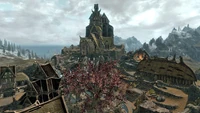
Whiterun.
Whiterun is a city in central Skyrim and capital of Whiterun Hold and the trading hub of the region.
This hold contains Whiterun and High Hrothgar, and was once referred to as the "Imperial City of Skyrim" before it underwent several acts of chaos including a dynastic feud, attacks by bandits and frost trolls, and a series of annihilating winters of alternating floods, droughts, and fires. A self-proclaimed priestess of Lorkhan, Jsashe the Witch-Queen, wielded de facto authority in the Hold and the local witches' coven, during the late Third Era.[12] The local giant population uses the grasslands and tundra outside Whiterun as a pasture for their mammoth herds, and a place to set camp, such as in Bleakwind Basin.
Winterhold Hold
- Main article: Winterhold (Skyrim Hold)
Winterhold, sometimes known as "The Winterhold," is one of the nine Holds of Skyrim. It is one of the four oldest holds in Skyrim, known collectively as Old Holds.[5] At one point Winterhold was the capital of Skyrim,[5] Its symbol is a crown. Winterhold is located on the north-east corner of Skyrim. It is a vastly cold region, most of the hold is covered in snowy tundra plains and high mountain ranges. Along the cost is a polar environment of glaciers and icebergs. The surrounding holds are Eastmarch, to the south, and The Pale, to the west.
Winterhold
- Main article: Winterhold (City)
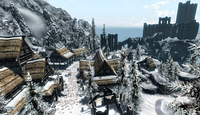
Winterhold.
Winterhold, the capital city of Winterhold Hold was once a wealthy and influential city and county in north-eastern Skyrim. Winterhold is heavily affected by Dunmer ways and ideas, being close to the border. It contains the Ysmir Collective and the well known College of Winterhold. Winterhold's current Jarl is Korir.
Due to The Great Collapse, most of the historic city sank into the ocean two hundred years prior to the dragon attacks. It is the smallest hold capital, with only a general goods store, an inn, the Jarl's Longhouse, and the College of Winterhold.
Eastmarch
- Main article: Eastmarch
Eastmarch is located along the eastern border with Morrowind. The northern part of Eastmarch features snowy tundras and mountains, while the central and southern areas of the Hold are volcanically active. The western part resembles much of central Skyrim, while the eastern part borders the Velothi Mountains. Eastmarch's major city, Windhelm, is located in the northern part of the hold.
A smaller settlement, known as Kynesgrove, is located south of Windhelm. Eastmarch's economy is supported by three farms, Brandy-Mug Farm, Hlaalu Farm and Hollyfrost Farm, all located just outside of Windhelm. Eastmarch is also supported by Mixwater Mill and four mines: Darkwater Crossing, Goldenrock Mine, Steamscorch Mine and Gloombound Mine.
Windhelm
- Main article: Windhelm
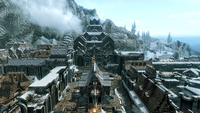
Windhelm.
Windhelm was once the capital of the First Empire of Skyrim, but as of the Fourth Era, it was the capital city of Eastmarch. The palace of the Ysgramor Dynasty still dominates the center of the Old City. Windhelm was sacked during the War of Succession, and again by the Akaviri army of Ada'Soon Dir-Kamal; the Palace of the Kings is one of the few First Empire buildings that remain. In the Second and Third Era, Windhelm was the only sizable city in the Hold of Eastmarch, and served as a base for Imperial troops guarding the Dunmeth Pass into Morrowind during Tiber Septim's reign.[5]
Following the Great War and the ensuing Skyrim Civil War, Windhelm became the primary hold of the Stormcloaks.[3]
Territories
Bleakrock Isle
Bleakrock Isle is located north of the Dunmer city of Blacklight and northeast of Windhelm. The ruling capital on the small island is Bleakrock Village which is the only real settlement on Bleakrock. There are a few Nordic ruins located on the isle including the massive ruins known as Skyshroud Barrow. Bleakrock Village has a set of ruins to the southeast of it called the Last Rest. Southwest of Bleakrock Village is a monument called Companions Point which depicts Ysgramor of the Five Hundred Companions.
Roscrea
Roscrea is an island located off the northern coast of Skyrim in the Sea of Ghosts. In the late third era, Solitude began to annex former Imperial territories including Roscrea.[12]
Government
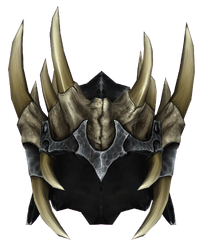
The Jagged Crown is a symbol of power for the rulers of Skyrim.
- "Maw unleashing razor snow,
Of dragons from the blue brought down,
Births the walking winter's woe,
The High King in his Jagged Crown." - ―Ancient Nordic verse describing the Jagged Crown[src]
The whole province of Skyrim is ruled by the High King (or Queen) and their consort. Each hold is ruled by a Jarl. Following the death of King Harald, the High King was chosen through a Moot of the Jarls,[5] which has varied in importance from the ultimate legitimiser of a High King's rule to a mere ceremonial acknowledgement of the heir apparent.[24][82] Disagreements over the Moot in the First Era led to the War of Succession in 1E 369, and after that a Moot has only been convened when the current High King has had no direct heir.[5]
Until the Stormcloak Rebellion and Civil War, the province was included in the Empire of Tamriel. While under this banner, Skyrim enjoyed military aid from the Emperor's army.[3][82]
The Jagged Crown was symbol of leadership and power of a High King or High Queen. It was made out of the teeth and bones of Dragons and was an ancient relic of the Nords. It was made for King Harald. The last High King to wear the crown was King Borgas and the crown was lost during the War of Succession.[24][83]
There are no known laws or legal documents of Skyrim. There were some surveys, censuses and records used by the government, such as the Book of Life, which was a census that kept track of people and livestock in a certain region.[84] The government also kept records of cities' general status and economic production. One such survey was the Survey of the Holdings of Jarl Gjalund, taken down during the First Era by Slafknir the Scribe, under the rule of Jarl Gjalund.[85]
Armed forces
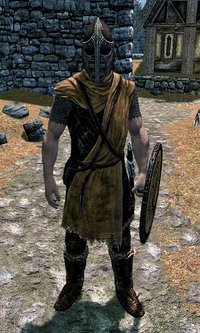
A Whiterun guard.
Other than the Imperial Legion and the Stormcloaks, Skyrim appears to have no centralized armed forces. Each Hold has its own section of Hold Guards who act as both a national guard and police force. These soldiers are the first line of defense against any opposing force who threatens Skyrim and her people. All the Hold Guards were Legion Soldiers prior to the Civil War and were able to be conscripted by the Empire in times of war.[54][86] After the Civil War erupted some time after the Markarth Incident, the Hold Guards of Skyrim were divided just as Skyrim itself was, with Haafingar, Hjaalmarch, The Reach and Falkreath Hold remaining loyal to Imperial control and Eastmarch, The Pale, The Rift and Winterhold Hold changing to Stormcloak control.
The Hold Guards and all armed forces are under the command of their respective Jarl of the nine Holds which are largely independent. However, in theory all Jarls must swear fealty to Skyrim's High King who can unify the Holds' armed forces into a centralized army.[3][82][74] The Nords' warlike character and history of conflict contributed much to Skyrim's formidable reputation. As an ally of the Empire, it was also considered to be the Empire's strong arm.[12]
Economy
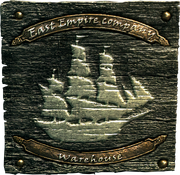
The East Empire Company symbol.
Skyrim is a wealthy and powerful province and traditionally was a profitable trading partner of the Third Empire.[87]
In the Fourth Era, Skyrim was politically unified until the outbreak of the Civil War, which pitted the Eastern Holds against the Western Holds. Although this, coupled with The Great Collapse, has caused some damage to Skyrim's economy, the city of Riften has become an industrial powerhouse, producing mead and fish. Skyrim is also abundant in a variety of wildlife that is hunted as prey by local hunters. These animals are hunted for their meat and pelts which can be sold or utilized for cooking and leather crafting.[88]
There are many forms of economic production in Skyrim. This includes agriculture, which is common despite the harsh and cold conditions, as well as grain production, mining, stone-cutting and logging. In Skyrim, there are many farms, Grain Mills, Mines, saw mills, docks and ports that produce goods and services. In addition, the trading and shipping industries are another part of Skyrim's economy. In each major city in Skyrim, of which there are five, there is a central marketplace where business, trading and social activities take place.
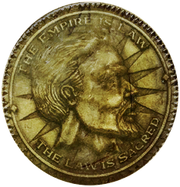
The Septim, the currency used in Skyrim.
Some cities, towns and villages produce specific goods and services. During the First Era, Rorik's Steading (Rorikstead) produced grain, leather and horses, Korvanjund produced hides and meat, Volunruud produced meat and worked ivory, Bromjunaar produced lumber and stone, Granite Hill held a weekly market and Hillgrund's Steading (Ivarstead).[85]
The East Empire Company is a multi-national, monopolistic trading and shipping company based out of Cyrodiil. The East Empire Company essentially dominates the shipping and trading industry in Solitude, which is a major shipping port of Skyrim.[74] However, the East Empire Company has been having troubles with the Blood Horker pirates, who were used by Clan Shatter-Shield to dimish the flow of Imperial goods to Skyrim, which in turn enabled Clan Shatter-Shield's trading and shipping business to rival them in Windhelm.[89]
Skyrim uses the Septim, which is the main currency used in Cyrodiil and throughout all of the Empire.
Demographics
Races
The most populous race in Skyrim are the Nords. However, people from all Tamrielic demographics can be found throughout the province.
Nords
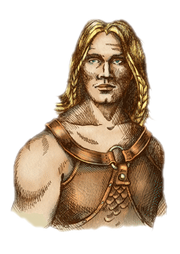
A depiction of a Nord male.
Nords consider themselves to be the children of the Sky. They call Skyrim the Throat of the World because it was where the sky first brought the North Winds upon land and formed them. Breath and the voice are the vital essences of a Nord; the art of breathing, speech and articulation is with them.[1] Though the art of speech is usually associated with the goddess Dibella, the art of the Thu'um, or Storm Voice,[90] is associated with Kynareth, who gave Men the ability to speak.[91]
Nearly all Nords have the capability to speak, but some have the capability of using the Thu'um, or Storm Voice. The power of these Nords can be articulated into a Shout.[92] The Way of the Voice was a pacifist philosophy developed by Jurgen Windcaller. The philosophy preached the Thu'um should only be used for worship and glory of the Gods rather than martial exploits. Jurgen Windcaller first developed this philosophy after the First Battle of Red Mountain in 1E 416. He then founded the Greybeards, a monastic group of Tongues who practice the Way of the Voice.[5][91]
Saunas are also popular in Skyrim.[93]
Religion
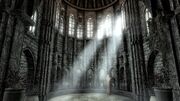
The Temple of the Divines in Solitude.
There are two religious pantheons of Skyrim, both worshiped in different time periods throughout Skyrim's history. The first was the Ancient Nordic Pantheon, worshiped during the Merethic and early First Era.[18] The Ancient Nordic Pantheon venerated animal gods; the deities were the hawk, wolf, snake, moth, owl, whale, bear, fox, and the dragon, which some scholars equate to the Nine Divines in different forms.[90][18] The second was the Nordic Pantheon, revered during the rest of Skyrim's history prior to the Fourth Era. During the Fourth Era they adapted to the Imperial Pantheon.[94][95]
The Nordic Pantheon consists of various deities, resembling the Nine Divines. Specific deities venerated by Skyrim and her people include: Alduin, Dibella, Orkey, Tsun, Mara, Stuhn, Kyne, Jhunal, Shor, Ysmir, Herma-Mora, Maloch.[90] Shor is considered the father deity of the province, as opposed to Akatosh, the chief Divine of Cyrodiil. Some scholars report that Akatosh and Alduin are the same deity, while others disagree.[90][96][97] Sovngarde is believed to be the Nordic afterlife created by Shor. When Nords, as well as anyone who believe in the Nordic Pantheon, die a heroic and honorable death, they ascend to Sovngarde.[98]
Daedra worship is rare in Skyrim, although the traditional Nordic Pantheon acknowledges some of these beings. These include Herma-Mora, an Atmoran demon who some claim is the incarnation of the Daedric Prince Hermaeus Mora. Mephala, the Daedric Princess and webspinner, is Herma's sister, supporting claims that he is a Daedric Prince. Mauloch, an incarnation of Malacath, is the patron of the ostracized.[90]
Other Daedric Princes worshiped in Skyrim are by those who do not follow predominant faiths in the provice. These include Azura—whose followers fled Morrowind after receiving spiritual dreams from their liege;[99] Nocturnal—worshiped by the Nightingales; Namira—worshiped by a cult of cannibals; and Hircine, largely patronized by lycanthropes.[3]
Talos worship
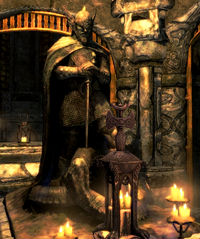
One of the last Shrines of Talos in Skyrim.
Because Tiber Septim liberated Skyrim from the elves, many consider his divine apothesized form, Talos, as worthy of veneration. Worship of Talos is prevalent in Skyrim, despite the Thalmor and the Elder Council signed the White-Gold Concordat as a treaty to the Great War conflict. The document contained explicit demands by the Third Aldmeri Dominion to uproot the worship of Talos in Cyrodiil and its territories. Skyrim, at the time, was a territory of the Empire of Tamriel, its High King being a member of the Elder Council. Loyalists supported the efforts of Imperial Legion and the Thalmor to eradicate Talos worship in Skyrim, although rebellious groups such as the Stormcloaks refused to relinquish these beliefs. Sometime after the Concordant was signed into law, the shrine of Talos in the Temple of the Divines was desecrated and removed.[100]
Culture
Music
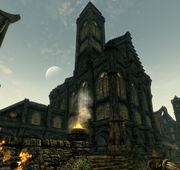
The Bard College found in Solitude.
Many songs are found in Skyrim's culture; some notable songs included Ragnar the Red, the Song of the Dragonborn, The Dragonborn Comes and Tale of the Tongues. Music is also popular in relation to war and propaganda. In the third century of the Fourth Era, when the Civil War was taking place, two songs were produced with lyrics altered to suit each side. The Age of Aggression was for the Empire and The Age of Oppression was for the Stormcloaks.[101] These songs are sung by Bards in Inns and Taverns all across Skyrim.
One very notable song of the past was King Olaf's Verse. The verse, written by Bard Svaknir, criticized King Olaf One-Eye and his adventures and referred to his adventures as "lurid and false." In response, King Olaf One-Eye ordered Svaknir to be imprisoned and all copies of his verse to burn.[102] In 4E 201, the Last Dragonborn joined the Bards College; their initiation task was to retrieve the last known copy of King Olaf's Verse from Dead Men's Respite.
Queen Elisif the Fair banned the Burning of King Olaf, a festival of the Bards College, after the death of her husband, Torygg. She considered it to be in bad taste. The Bards,however, desired for the festival to take place. Viarmo and the Last Dragonborn went to Elisif the Fair and presented to her King Olaf's Verse. Elisif soon allowed holding of the Burning of King Olaf festival. The festival was to be held that day, and for all days in the future when the festival was to take place.[103]
Festivals and holidays
A few notable holidays and festivals are customary in Skyrim and in Nordic culture. One notable festival is the Feast of the Dead, which is held on the 13th of Sun's Dawn in Windhelm to honor Ysgramor and the Five Hundred Companions. During the festival, the names of the Five Hundred are recited.[5]
Architecture and infrastructure
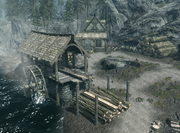
Solitude Sawmill, an example of architecture that can be found in Skyrim.
The architecture and infrastructure of Skyrim is a mix of rural and urban; much of Skyrim is untamed wilderness, broken up by nine major cities spread across the province. Of these nine cities, there are five that are more urbanized, heavily populated, and more city-like, and four that are smaller, less populated, and more rural in nature.[3]
The actual architecture of the buildings varies, but it is unknown what they were based on. The city of Markarth was originally built by the ancient Dwemer. The buildings were made of stone and the unique metal known only to the Dwemer. After the Dwemer disappeared in 1E 700, people started to settle into Markarth, so the Nords who settled the city did not have to use their cultural styles of architecture and infrastructure.[104]
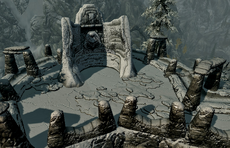
A Word Wall in Skyrim.
Examples of Ancient Nordic architecture include longhouses, with "each beam and cornice festooned with carvings of dragons, bulls, boars, leering wild men, and dancing, long-tressed women."[105] The Ancient Nords, known as the Atmorans, built massive structures called Word Walls. Whether it was out of fear or respect, the Ancient Nords learned the language and writing system of the dragons.[106]

There are also examples of Akaviri architecture present in Skyrim. Sometime during the First Era, Sky Haven Temple was constructed for and by the Akaviri Dragonguard. In 1E 2812, Emperor Reman II permitted the construction of Alduin's Wall in the Temple,[107] a massive stone mural built to record all of the Akaviri's accumulated dragon-lore and the Prophecy of the Dragonborn. Sky Haven Temple and Alduin's Wall are testaments to Akaviri architecture and sculpturing, and is considered to be some of the best preserved examples of early Akaviri structures and sculptures.[107][108]
Education
Three colleges are recorded as existing in Skyrim throughout its history: the Imperial College of the Voice in Markarth,[5] the Bards College in Solitude, and the College of Winterhold in Winterhold.[3] Tiber Septim endowed a college in Markarth to begin teaching the Voice as a tool of war,[5] but whether this college began teaching or not is unclear. There is no trace of the college in any of the games.
Appearances
- The Elder Scrolls: Arena
- The Elder Scrolls II: Daggerfall (mentioned only)
- The Elder Scrolls Adventures: Redguard (mentioned only)
- The Elder Scrolls Travels: Dawnstar
- The Elder Scrolls Travels: Shadowkey
- The Elder Scrolls III: Morrowind (mentioned only)
- The Elder Scrolls IV: Oblivion (mentioned only)
- The Elder Scrolls V: Skyrim
- The Elder Scrolls Online
Notes
- ↑ If divided differently, the word Keizaal can become Keiza-Al, which translates to "to Rebellion-Destroyer."
References
- ↑ 1.0 1.1 Children of the Sky
- ↑ 2.0 2.1 2.2 Provinces of Tamriel
- ↑ 3.0 3.1 3.2 3.3 3.4 3.5 3.6 3.7 3.8 3.9 The Elder Scrolls V: Skyrim
- ↑ Dialogue with Knight-Paladin Gelebor
- ↑ 5.00 5.01 5.02 5.03 5.04 5.05 5.06 5.07 5.08 5.09 5.10 5.11 5.12 5.13 5.14 5.15 5.16 5.17 5.18 5.19 5.20 5.21 5.22 5.23 5.24 5.25 Pocket Guide to the Empire, First Edition: Skyrim
- ↑ The Annotated Anuad
- ↑ 7.0 7.1 7.2 7.3 Before the Ages of Man
- ↑ Yngol and the Sea-Ghosts
- ↑ Night of Tears – Dranor Seleth
- ↑ Imperial Report on Saarthal
- ↑ 11.0 11.1 11.2 Songs of the Return, Vol 2
- ↑ 12.0 12.1 12.2 12.3 12.4 Pocket Guide to the Empire, Third Edition: Skyrim – Imperial Geographic Society
- ↑ 13.0 13.1 13.2 13.3 Fall of the Snow Prince
- ↑ 14.0 14.1 The Falmer: A Study – Ursa Urthrax
- ↑ Songs of the Return, Vol 27
- ↑ Songs of the Return, Vol 7
- ↑ Songs of the Return, Vol 19
- ↑ 18.0 18.1 18.2 18.3 18.4 18.5 The Dragon War – Torhal Bjorik
- ↑ Seven Thousand Steps Etchings
- ↑ Alduin's Bane
- ↑ Note (Forelhost 1)
- ↑ 22.0 22.1 Pocket Guide to the Empire, First Edition: Morrowind
- ↑ Nerevar at Red Mountain – Alandro Sul
- ↑ 24.0 24.1 24.2 24.3 24.4 24.5 24.6 The Crown of Freydis – Taleon Mythmaker
- ↑ Pocket Guide to the Empire, Third Edition: High Rock
- ↑ Olaf and the Dragon – Adonato Leotelli
- ↑ 27.0 27.1 Windhelm Palace of the Kings Plaque
- ↑ 28.0 28.1 Rislav the Righteous
- ↑ 29.0 29.1 29.2 29.3 Five Songs of King Wulfharth
- ↑ Kagrenac's Tools
- ↑ 31.0 31.1 History of the Fighters Guild
- ↑ Orcs of Skyrim – Thora Far-Wanderer
- ↑ 33.0 33.1 33.2 The Second Akaviri Invasion – by Yngmaer Raven-Quill
- ↑ 34.0 34.1 Jorunn the Skald-King – Helgreir Lute-Voice
- ↑ 35.0 35.1 The Brothers' War
- ↑ 36.0 36.1 Guide to the Ebonheart Pact
- ↑ Events of The Elder Scrolls Online
- ↑ Battle of Sancre Tor
- ↑ Pocket Guide to the Empire, First Edition
- ↑ The Wolf Queen, Book II – Waughin Jarth
- ↑ Biography of the Wolf Queen – Katar Eriphanes
- ↑ The Wolf Queen, Book III – Waughin Jarth
- ↑ The Wolf Queen, Book VI – Waughin Jarth
- ↑ 44.0 44.1 Brief History of the Empire, Book I – Stronach k'Thojj III
- ↑ The Wolf Queen, Book VI – Waughin Jarth
- ↑ Brief History of the Empire, Book II
- ↑ The Wolf Queen, Book VIII
- ↑ Events of The Elder Scrolls IV: Oblivion
- ↑ History of Raven Rock, Vol. I – Lyrin Telleno
- ↑ Lymdrenn Tenvanni's Journal
- ↑ Events of The Elder Scrolls V: Dragonborn
- ↑ An Elder Scrolls Novel: Lord of Souls
- ↑ Decree of Monument
- ↑ 54.0 54.1 54.2 54.3 54.4 54.5 The Bear of Markarth – Arrianus Arius
- ↑ The Bear of Markarth
- ↑ Dialogue with Nepos the Nose during "The Forsworn Conspiracy"
- ↑ Dialogue with Braig
- ↑ 58.0 58.1 Dialogue with Igmund
- ↑ Dialogue with Alvor
- ↑ Dialogue with Thalmor Justiciars
- ↑ Dialogue with Solaf
- ↑ Dialogue with Saerlund
- ↑ Dialogue with Elisif the Fair
- ↑ Dialogue with Ralof
- ↑ Dialogue with Ulfric Stormcloak
- ↑ 66.0 66.1 Dialogue with Vulwulf Snow-Shod
- ↑ Dialogue with Balgruuf the Greater
- ↑ Dialogue with Captain Aldis
- ↑ The Book of the Dragonborn
- ↑ Events of the Main Quest
- ↑ Herbalist's Guide to Skyrim
- ↑ Sinderion's Field Journal
- ↑ The Nirnoot Missive – Sinderion
- ↑ 74.0 74.1 74.2 74.3 Loading Screens (Skyrim) Cite error: Invalid
<ref>tag; name "LoadingScreensSkyrim" defined multiple times with different content Cite error: Invalid<ref>tag; name "LoadingScreensSkyrim" defined multiple times with different content - ↑ 75.0 75.1 The Holds of Skyrim: A Field Officer's Guide, For Use By Officers of the Imperial Legion
- ↑ The Elder Scrolls V: Skyrim Game Guide
- ↑ Lost Legends
- ↑ Was thus named in The Elder Scrolls: Arena
- ↑ The Real Barenziah, Book II – Plitinius Mero
- ↑ King Olaf's Verse
- ↑ Flight from the Thalmor - Hadrik Oaken-Heart
- ↑ 82.0 82.1 82.2 Skyrim's Rule: An Outsider's View – Abdul-Mujib Ababneh
- ↑ Dialogue with Galmar Stone-Fist
- ↑ A History of Daggerfall – Odiva Gallwood
- ↑ 85.0 85.1 Holdings of Jarl Gjalund – Slafknir the Scribe
- ↑ Dialogue between Elisif the Fair and Bolgeir Bearclaw
- ↑ Dialogue of Balgruuf the Greater
- ↑ Nords of Skyrim – My People, My Pride – Hrothmund Wolf-Heart
- ↑ Rise in the East
- ↑ 90.0 90.1 90.2 90.3 90.4 Varieties of Faith in the Empire – Mikhael Karkuxor
- ↑ 91.0 91.1 Dialogue with Arngeir
- ↑ Children of the Sky
- ↑ An Elder Scrolls Novel: The Infernal City pg 196
- ↑ Dialogue with Cirroc
- ↑ Dialogue with Antonius Nuncius
- ↑ The Alduin/Akatosh Dichotomy: Book Seven of 2920, The Last Year of the First Era – Alexandre Simon, High Priest of the Akatosh Chantry, Wayrest
- ↑ Alduin is Real – Thromgar Iron-Head
- ↑ Sovngarde, a Reexamination – Bereditte Jastal
- ↑ Dialogue with Aranea Ienith
- ↑ Dialogue with a priest in the Temple of the Divines
- ↑ Songs of Skyrim – Giraud Gemane
- ↑ Dialogue with Giraud Gemane
- ↑ Events of "Tending the Flames"
- ↑ The City of Stone: A Sellsword's Guide to Markarth – Amanda Alleia
- ↑ An Elder Scrolls Novel: The Infernal City pg 121
- ↑ Dragon Language: Myth no More – Hela Thrice-Versed
- ↑ 107.0 107.1 Annals of the Dragonguard – Brother Annulus
- ↑ Dialogue with Esbern
| Provinces | |
|---|---|
| Tamriel | |
| Akavir | |

